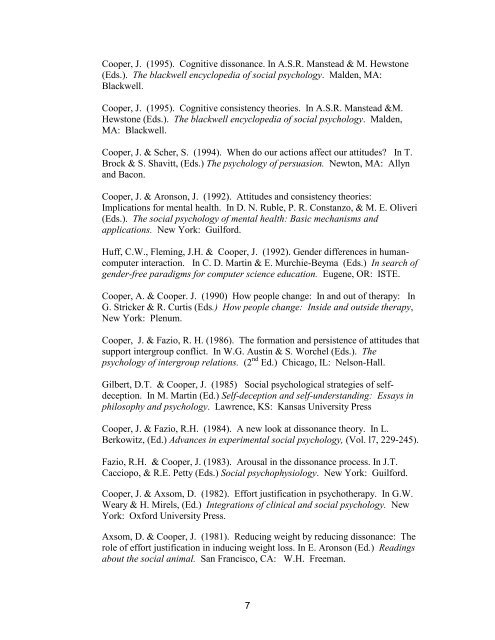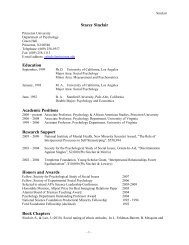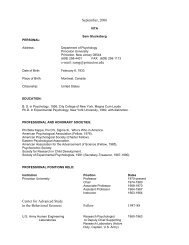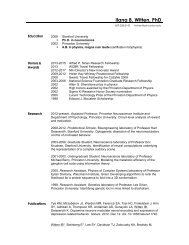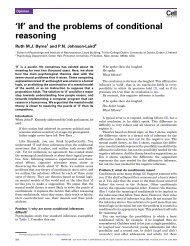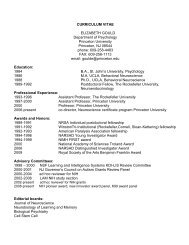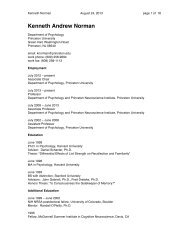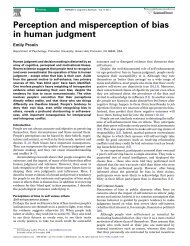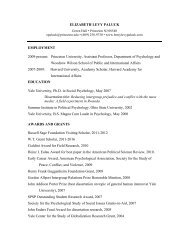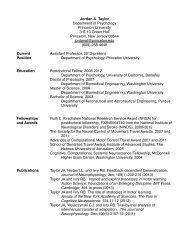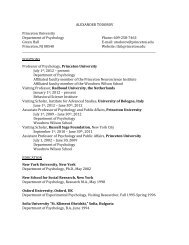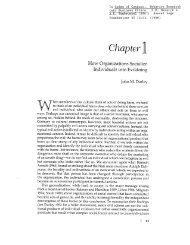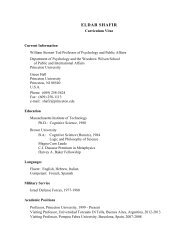VITA Joel Cooper - Princeton University - Department of Psychology
VITA Joel Cooper - Princeton University - Department of Psychology
VITA Joel Cooper - Princeton University - Department of Psychology
Create successful ePaper yourself
Turn your PDF publications into a flip-book with our unique Google optimized e-Paper software.
<strong>Cooper</strong>, J. (1995). Cognitive dissonance. In A.S.R. Manstead & M. Hewstone(Eds.). The blackwell encyclopedia <strong>of</strong> social psychology. Malden, MA:Blackwell.<strong>Cooper</strong>, J. (1995). Cognitive consistency theories. In A.S.R. Manstead &M.Hewstone (Eds.). The blackwell encyclopedia <strong>of</strong> social psychology. Malden,MA: Blackwell.<strong>Cooper</strong>, J. & Scher, S. (1994). When do our actions affect our attitudes? In T.Brock & S. Shavitt, (Eds.) The psychology <strong>of</strong> persuasion. Newton, MA: Allynand Bacon.<strong>Cooper</strong>, J. & Aronson, J. (1992). Attitudes and consistency theories:Implications for mental health. In D. N. Ruble, P. R. Constanzo, & M. E. Oliveri(Eds.). The social psychology <strong>of</strong> mental health: Basic mechanisms andapplications. New York: Guilford.Huff, C.W., Fleming, J.H. & <strong>Cooper</strong>, J. (1992). Gender differences in humancomputerinteraction. In C. D. Martin & E. Murchie-Beyma (Eds.) In search <strong>of</strong>gender-free paradigms for computer science education. Eugene, OR: ISTE.<strong>Cooper</strong>, A. & <strong>Cooper</strong>. J. (1990) How people change: In and out <strong>of</strong> therapy: InG. Stricker & R. Curtis (Eds.) How people change: Inside and outside therapy,New York: Plenum.<strong>Cooper</strong>, J. & Fazio, R. H. (1986). The formation and persistence <strong>of</strong> attitudes thatsupport intergroup conflict. In W.G. Austin & S. Worchel (Eds.). Thepsychology <strong>of</strong> intergroup relations. (2 nd Ed.) Chicago, IL: Nelson-Hall.Gilbert, D.T. & <strong>Cooper</strong>, J. (1985) Social psychological strategies <strong>of</strong> selfdeception.In M. Martin (Ed.) Self-deception and self-understanding: Essays inphilosophy and psychology. Lawrence, KS: Kansas <strong>University</strong> Press<strong>Cooper</strong>, J. & Fazio, R.H. (1984). A new look at dissonance theory. In L.Berkowitz, (Ed.) Advances in experimental social psychology, (Vol. l7, 229-245).Fazio, R.H. & <strong>Cooper</strong>, J. (1983). Arousal in the dissonance process. In J.T.Cacciopo, & R.E. Petty (Eds.) Social psychophysiology. New York: Guilford.<strong>Cooper</strong>, J. & Axsom, D. (1982). Effort justification in psychotherapy. In G.W.Weary & H. Mirels, (Ed.) Integrations <strong>of</strong> clinical and social psychology. NewYork: Oxford <strong>University</strong> Press.Axsom, D. & <strong>Cooper</strong>, J. (1981). Reducing weight by reducing dissonance: Therole <strong>of</strong> effort justification in inducing weight loss. In E. Aronson (Ed.) Readingsabout the social animal. San Francisco, CA: W.H. Freeman.7


